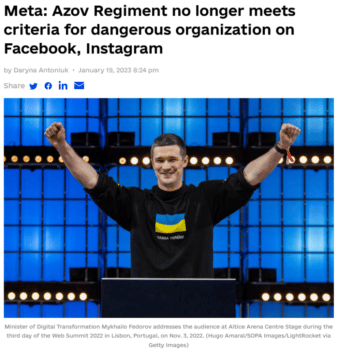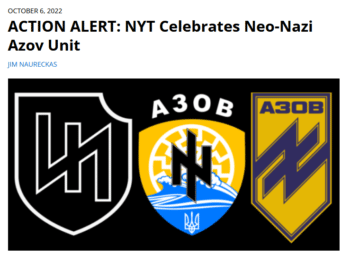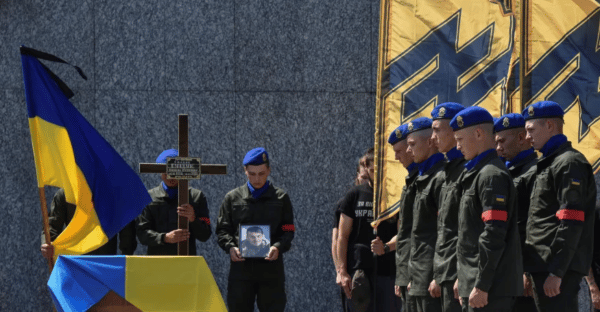
Good news! Neo-Nazis are no longer dangerous, says Facebook (Kyiv Independent, 1/19/23).
Meta, the parent company of Facebook, announced on January 19 that the company no longer considers Ukraine’s Azov Regiment to be a “dangerous organization.” The far-right paramilitary group grew out of the street gangs that helped topple Ukraine’s president in the US-backed 2014 coup. Originally funded by the same Ukrainian oligarch that backed President Volodymyr Zelenskyy’s rise to power, Azov was on the front lines of civil war in Eastern Ukraine, and was later fully integrated into the Ukrainian national guard.
The main outlet to report on this move was the Kyiv Independent (1/19/23), a Ukrainian newsroom closely linked to Western “democracy promotion” initiatives. These ties are reflected in its coverage of Facebook’s move. Take the description of the Azov Regiment:
The group has sparked controversy over its alleged association with far-right groups—a recurring theme used by Russian propaganda.
The “association” with “far-right groups” has been far more than “alleged,” and is well documented and openly acknowledged by members of the organization. Even the use of “far-right” downplays the fact that they have regularly been seen sporting Nazi symbols and even making Nazi salutes. NATO was forced to apologize after tweeting a photo of the regiment, circulated as part of public relations for the war, in which a soldier was wearing a symbol from the Third Reich (Newsweek, 3/9/22).

The danger of white-supremacist military units used to be widely acknowledged in corporate media (Time, 1/7/21; see FAIR.org, 5/18/22).
Even the logo of the Regiment is a variant of a popular Nazi symbol. Another Nazi symbol affiliated with Azov was printed on the Christchurch, New Zealand, shooter’s jacket as he opened fire on multiple mosques in 2019.
The founder of the regiment once asserted (Guardian, 3/13/18) that Ukraine’s mission was to “lead the white races of the world in a final crusade…against Semite-led Untermenschen.”
Even the US Congress, who was funding the Ukrainian military years before the war, acknowledged the regiment’s neo-Nazi affiliation. In 2018, it passed a law restricting those funds from going to Azov fighters (The Hill, 3/27/18). However, officials on the ground acknowledged that there was never any real mechanism preventing the aid from reaching Azov (Daily Beast, 12/8/19).
The Kyiv Independent article was republished in the US press by Yahoo News (1/19/23)—with a note appended with a link to the Independent’s Patreon fundraising account.
The Washington Post (1/21/23) also reported on the move, suggesting that the “Azov Regiment” is now separate from the “Azov Movement,” since the Regiment is now formally under the control of the Ukrainian military. The Post, which called the Regiment “controversial,” did not criticize Meta’s move, and instead highlighted Mykhailo Fedorov, Ukraine’s minister of digital transformation, who praised the decision.

The emblem of the 2nd SS Panzer Division (left) compared with those of the Azov Battalion (center) and Azov Regiment (right) (FAIR.org, 10/6/22).
The tech news site Engadget (1/21/23) noted that “the change will allow members of the unit to create Facebook and Instagram accounts.”
Backing NATO PR
This isn’t the first time that the platform’s policies were used to promote US public relations objectives. In February 2022, Facebook announced that it would carve out an exception to its policy against praising white supremacy to accommodate the Azov Regiment (Business Insider, 2/25/22). In March 2022, Facebookannounced it would allow posts calling for violence against Russians within the context of the invasion (Intercept, 4/13/22). This included allowing users to call for the death of Russian President Vladimir Putin, and even Belarusian President Alexander Lukashenko.
Facebook encouraged even more ethnic hate against Russians by relaxing policies on violent or hateful speech against Russian individuals. Materials reviewed by the Intercept (4/13/22) showed that Facebook and Instagram users were now allowed to call for the “explicit removal [of] Russians from Ukraine and Belarus.” In sharp contrast with its policy against allowing graphic images of the victims of Israel’s attacks on Palestine, the platform began to allow users to post such images from Russia’s invasion (Intercept, 8/27/22).
All of this has contributed to the normalization, or even embrace of neo-Nazis in the US. Early in the war, Western media uncritically promoted an Azov publicity event while making no mention of the group’s Nazi ties (FAIR.org, 2/23/22). In October, the New York Times (10/4/22) wrote a laudatory article about “Ukraine’s celebrated Azov Battalion” that completely ignored the group’s Nazi ties (FAIR.org, 10/6/22). An Azov soldier with a Nazi tattoo was even welcomed to Disney World by liberal icon Jon Stewart (Grayzone, 8/31/22).
All of this comes as US media promote ostensible concern about the growth and influence of the far right at home. This blind spot is especially egregious, given the numerous accounts of US white supremacists going to Ukraine to train with the Azov Regiment in preparation of a new US civil war (Vice, 2/6/20).

